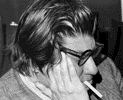There is an obvious issue in Morton Feldman’s compositional technique that I have never seen anyone write about – though I can’t be the only one to notice it, and perhaps some discussion of it has escaped my reading.
 Through some passages of Feldman’s late works, it is remarkable – too remarkable for mere coincidence – how often his textures change at the end of a page. It doesn’t seem true at the beginnings of pieces, which will often be seamless. But at some point in a work, he will begin to settle into a rhythm. A texture or pitch set will be consistent for a page, and then the next page will have a different texture and pitch set, and the next page a different one still, and so on. It is almost as though he treated the page visually, as a whole, and every time he turned to a new page, thought, “Now for something new.”
Through some passages of Feldman’s late works, it is remarkable – too remarkable for mere coincidence – how often his textures change at the end of a page. It doesn’t seem true at the beginnings of pieces, which will often be seamless. But at some point in a work, he will begin to settle into a rhythm. A texture or pitch set will be consistent for a page, and then the next page will have a different texture and pitch set, and the next page a different one still, and so on. It is almost as though he treated the page visually, as a whole, and every time he turned to a new page, thought, “Now for something new.”
For instance: in Crippled Symmetry there are no particular texture changes at page turns until page 5. The flute spends most of pages 5 and 6 on a motive in sevenths, Eb – Db – C – D, which ends when page 7 begins. Then:
– On page 9 the flutist plays only long, low notes on E, F, and Gb, and the percussionist plays only slow chords on the vibraphone alternating with single notes on the glockenspiel.
– On page 10, the flutist switches to angular motives on the regular flute, and the percussionist to the Eb – Db – C – D motive.
– On page 11, the flutist plays only reiterated Bbs above the treble clef, while the vibraphone is limited to a motive G – F# – B – A.
– On page 12, the flute takes up a different four-note motive, and the percussion is now limited to a reiterated Bb.
And so on, with changes of texture, pitch set, notation, and even number of staves occurring regularly with the turn of each new page. This is all the more peculiar in Crippled Symmetry, of course, because the three parts (flute, piano, percussion) aren’t synchronized. Presumably, Feldman doesn’t want such changes in texture and motive happening simultaneously, and thus waits until several pages into the piece before implementing them.
For Samuel Beckett for orchestra demonstrates an analogous relation to the page in a synchronized score. On pages 6, 8, 12, and 13, the last four or five measures are encapsulated in repeat signs. On pages 14, 15, and 16, each entire individual page is repeated. On pages 17, 18, and 19, the page is broken into two passages, each in repeat signs. Later we have a long passage in which, on each new page, repeat signs encompass every measure except the first and last. Neither here nor in Crippled Symmetry does any passage within repeat signs cross from one page to another. (Not every late piece is structured this way. I find no such changes in For Christian Wolff, and only a few, more inconclusively, in Clarinet and String Quartet.)
It is difficult to escape the impression that sometimes Feldman planned out each page individually, as an artist would. Sometimes in For Samuel Beckett the page is planned out symmetrically, making a contained and visible palindrome. Luckily, the Universal editions of these scores are copies of Feldman’s manuscript, because if you engraved them, the pagination would likely change and obscure the relationship (as may have happened in the engraved piano works, like Triadic Memories and Piano). Evidence suggests that he composed the music on these pages – or, at least, when recopying, took care to maintain the same pagination.
It’s an odd thought because, of course, a page is not a unit of musical time. We don’t hear a page go by, or, usually, know from listening when one ends. But Feldman’s music is often devoid of striking temporal landmarks, and the sense of experienced time becomes vague and immeasurable. For him, I suppose any long unit of time was as good as another. He loved exploring notation’s psychological effect on the performer, and apparently he gave free rein to its psychological effect on himself too. A page became just the right length for a section of music, and, sitting in his study, each time he turned the page, it was time for something new.
Photo by Peter Gena
